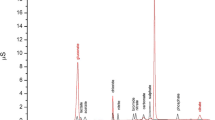Summary
A pure culture of the fungusCorticium microsclerotia (Matz) Weber, obtained from the Centraalbureau voor Schimmelcultures, Baarn, Holland, was found to be thiamine heterotrophic, when cultured on a glucose nitrate medium.
Under the cultural conditions employed the fungus was observed to reach its maximum growth in about 15 days, in the presence of an optimum amount of 2·0 µg. of thiamine per flask, containing 20 ml. of medium. The fungus did not require the intact thiamine molecule as such and grew almost equally well when supplied with an equimolar mixture of thiazole and pyrimidine. The fungus also had the ability to slowly complete the synthesis of thiamine from pyrimidine alone, but not from thiazole.
Similar content being viewed by others
References
Bonner, J. and Buchman, E. R. “The synthesis and destruction of vitamin B1 byPhycomyces,”Proc. nat. Acad. Sci., U.S.A., 1939,25, 164–71.
Fries, N. “The nutrition of fungi from the aspect of growth factor requirements,”Trans. Brit. mycol. Soc., 1948,30, 118–34.
Hawker, L. E.Physiology of Fungi, University of London Press, London, 1950.
Hemmi, T. and Endo, S. “Studies on sclerotium diseases of the rice plant, VI. On the relation of temperature and period of continuous wetting to the infection of the rice plant byHypochnus sasakii Shirai,”Forsch. Geb. Pflan. Krankh. (Kyoto), 1933,2, 202–18.
Leonian, L. H. and Lilly, V. G. “Studies on the nutrition of fungi.III. Auxithals synthesised by some filamentous fungi,”Plant physiol., 1940,15, 515–25.
Lilly, V. G. and Barnett, H. L.Physiology of the Fungi, McGraw Hill Book Company, New York, 1951.
Mathew, K. T. “Growth-factor requirements ofPellicularia koleroga Cooke in pure culture,”Nature. 1952,170, 889–90.
Mueller, W. F. and Schopfer, W. H. “L’action de l’aneurine et de ses constituants surMucor ramannianus Möll,”C. R. Acad. Sci., Paris, 1937,205, 687–89.
Norkrans, B. “Studies in growth and cellulolytic enzymes ofTricholoma with special reference to mycorrhiza formation,”Symb. Bot. Ups., 1950,11, 1–126.
Robbins, W. J. “Thiamin and growth of species ofPhytophthora,”Bull. Torrcy. bot. Cl., 1938,65, 267–76.
Robbins, W. J. “Growth substances in agar,”Amer. J. Bot., 1939,26, 772–78.
— “Intermediates of vitamin B1 and growth ofPhycomyces,”Proc. nat. Acad. Sci., U.S.A., 1937,23, 499–502.
— “Intermediates of vitamin B1 and the growth ofTorula,”Plant Physiol., 1938a,13, 611–19.
— “Thiamin and growth ofPythium butleri,”Bull. Torrey bot. Cl., 1938b,65, 453–61.
— “Vitamin B1 its intermediates and growth of certain fungi,”Amer. J. Bot., 1938c,25, 229–36.
— “Vitamin deficiencies of the filamentous fungi,”Bot. Rev., 1942,8, 411–71.
Ryker, T. C. “TheRhizoctonia disease of bermuda grass, sugarcane, rice and other grasses in Louisiana,”Proc. Sixth Congr. Int. Sugarcane Tech., 1938, 198–201.
Schopfer, W. H. “L’action des constituants de l’aneurine surides levures (Rhodotorula rubra etflava),”C. R. Acad. Sci., Paris, 1937,205, 445.
— “La pyrimidine facteur de Croissance de microorganisme (Rhodotorula, Mucorinees,Dematium),”Protoplasma, 1938,31, 105.
-Plants and Vitamins, Chronica Botanica Co., Waltham, Mass., 1943.
Schopfer, W. H. and Jung, A. “L’action des produits de desintegration de l’aneurine surPhycomyces. Le second facteur de croissance des Mucorinees,”C. R. Acad. Sci., Paris, 1937,204, 1500.
Sinclair, H. M. “Growth factors forPhycomyces,”Nature, 1937,140, 361.
Steinberg, R. A. “A study of some factors in the chemical stimulation of the growth ofAspergillus niger,”Amer. J. Bot., 1919,6, 330–72.
— “The nutritional requirements of the fungusAspergillus niger,”Bull. Torrey bot. Cl., 1935,62, 81–90.
— “Some effects of the heavy metals essential for the nutrition ofAspergillus niger upon its growth,”Amer. J. Bot., 1936,23, 227–31.
— “Role of molybdenum in the utilization of ammonium and nitrate nitrogen byAspergillus niger,”J. agric. Res., 1937,55, 891–901.
— “The essentiality of Gallium to growth and reproduction ofAspergillus niger,” —, 1938,57, 569–74.
Author information
Authors and Affiliations
Additional information
Communicated by Prof. T. S. Sadasivan,m.sc.,ph.d., f.a.sc.
An erratum to this article is available at http://dx.doi.org/10.1007/BF03050363.
Rights and permissions
About this article
Cite this article
Mathew, K.T. Thiamine, its intermediates and growth ofCorticium microsclerotia (Matz) Weber. Proc. Indian Acad. Sci. 38, 1–9 (1953). https://doi.org/10.1007/BF03051161
Received:
Issue Date:
DOI: https://doi.org/10.1007/BF03051161




